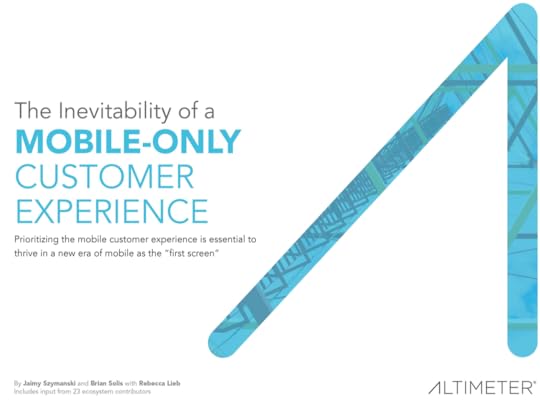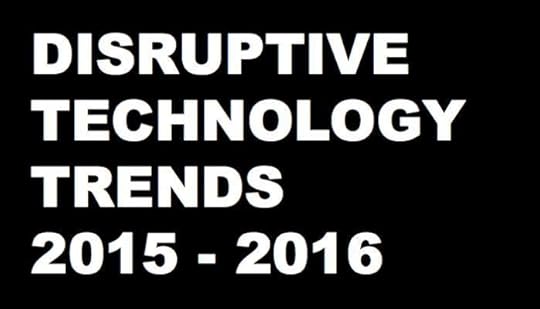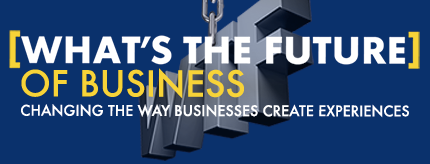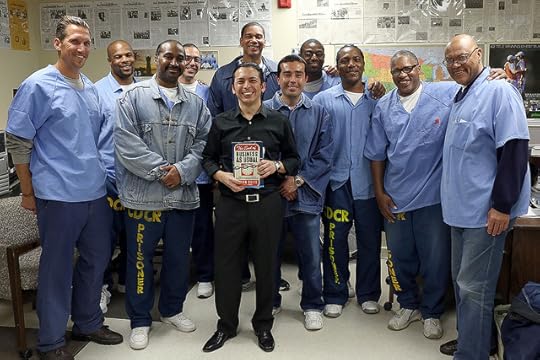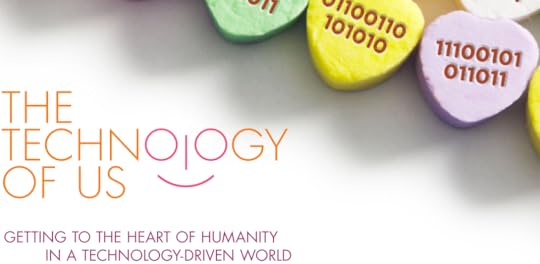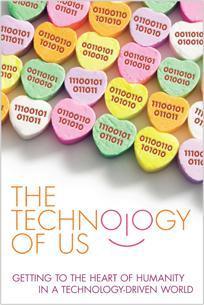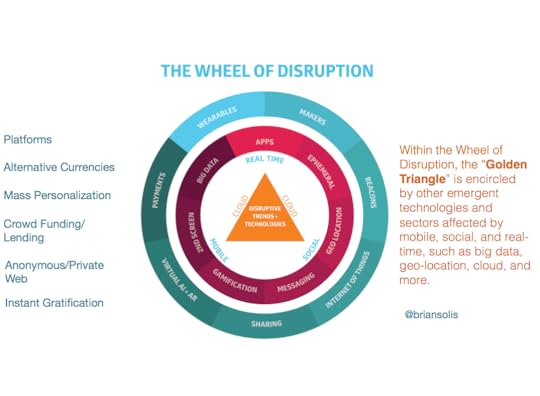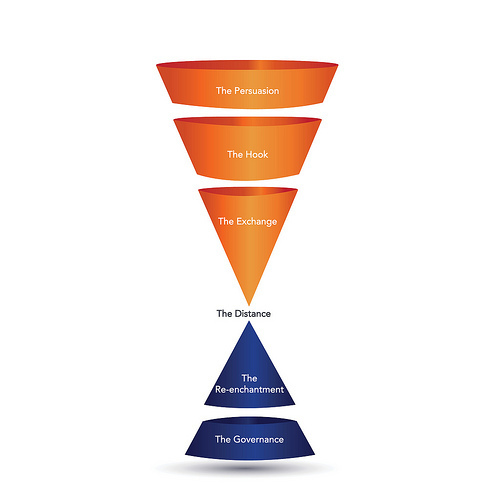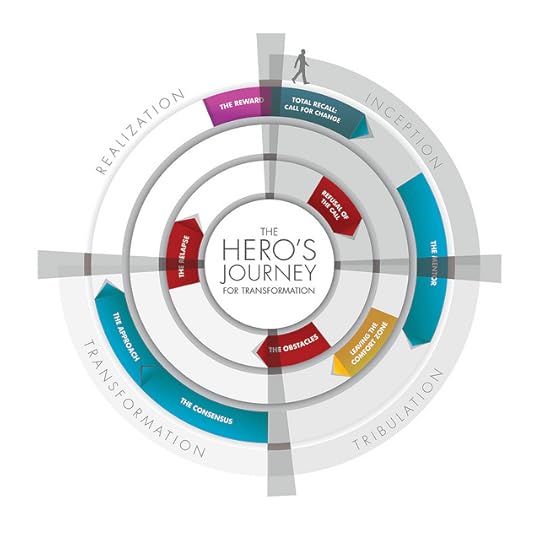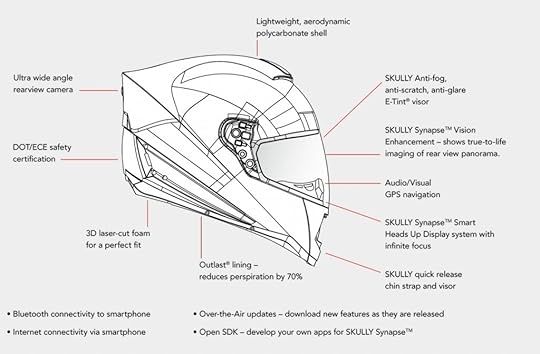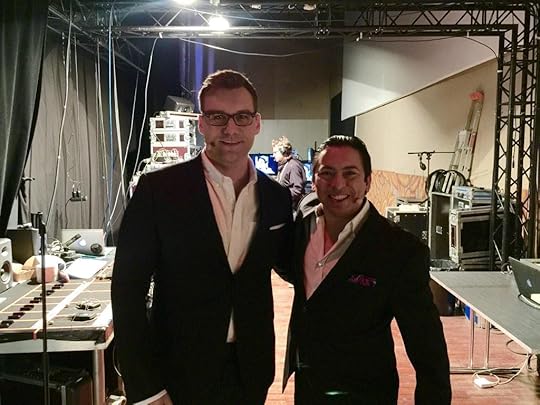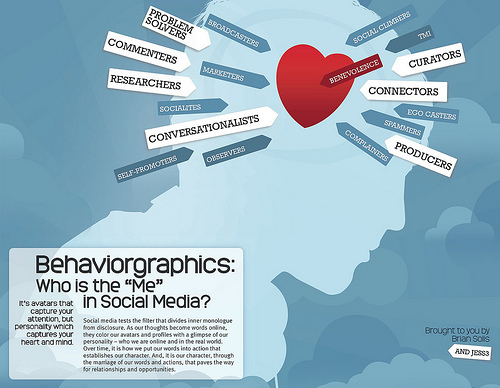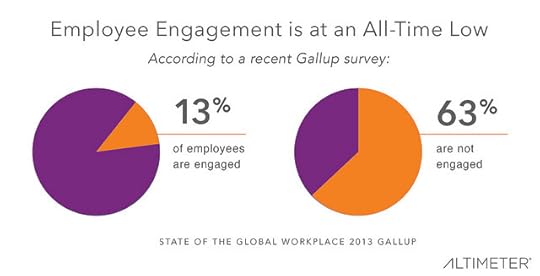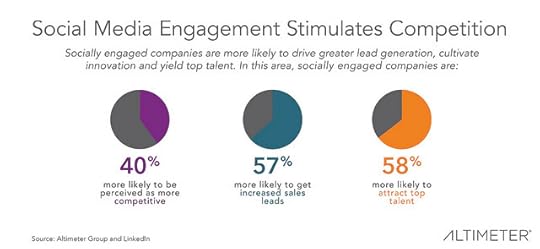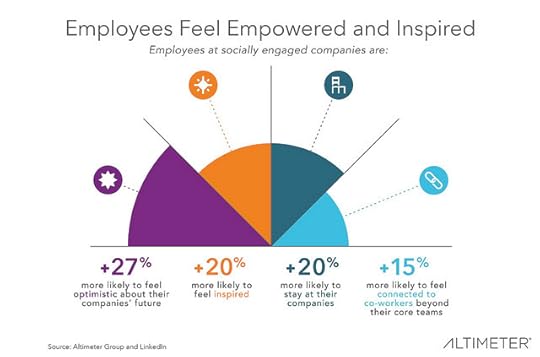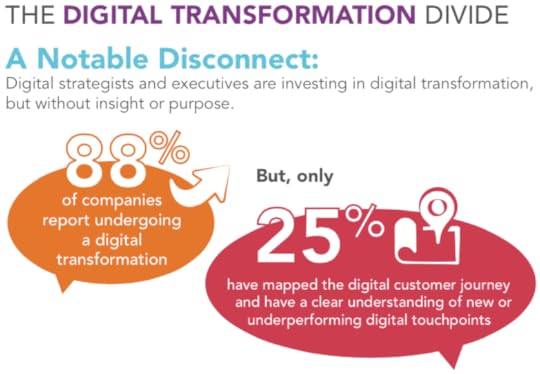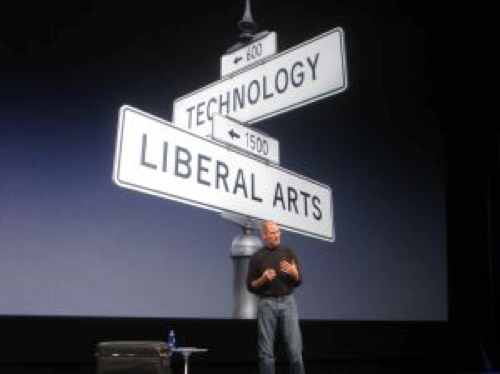Brian Solis's Blog, page 106
January 22, 2015
Research: Some Brands Go All In on Mobile; Others Suffer from Mobile Mediocrity
Consumers aren’t just going digital, they’re also becoming increasingly mobile. To them, mobile isn’t the second screen, it’s the first screen. Brands however, struggle to keep up with them and as a result, mobile strategies are off target or underwhelming.
This finding among many others is the result of new research conducted by my colleague Jaimy Szymanski and me. I’m proud to announce that the report, The Inevitability of a Mobile-Only Customer Experience, is available today for immediate download.
Mobile CX: Digital First and Mobile First
After spending several months interviewing brands such as Starbucks, MasterCard, Nespresso, Starwood and 19 other leading companies, we learned that while there’s significant progress in mobile, there’s still a lot of work ahead.
Today, there is a tug-of-war between digital first and mobile first approaches in customer experience. What if they were mutually exclusive? What if brands invested in digital first and also mobile only customer journeys?
Digital transformation needs a sense of urgency and that’s where champions are desperately needed. Our research shows that digital or mobile first isn’t good enough. For many companies, mobile technology further fragments the customer experience.
90% of consumers move between devices to accomplish a goal, using an average of three different screen combinations each day. At some point, multiscreen fatigue will force consumers to abandon any customer journey that doesn’t prioritize mobile only experiences.
We all know that digital is a priority for brands. We also know that strategists still struggle to get executive support and necessary resources and budget to make critical moves as the digital landscape continues to evolve. But if we are to create a sense of urgency, we must understand that as mobile becomes the first screen, the entire journey must be reimagined. As it is, the digital customer journey largely exists as a remnant from the days of Web 1.0.
As mobile consumers become more and more proficient at navigating customer journeys via the small screen, they are learning how to bypass outmoded touchpoints. By not truly understanding mobile customer behavior, brands cannot invest in a meaningful mobile customer experience. This causes friction and forces consumers to multiscreen and/or channel hop instead of going through the funnel or their journey with ease and delight. As such, mobile CX is of vital importance if brands are to succeed in the digital economy.
Somewhere along the way, mobile strategy simply became an extension of all things digital. But mobile consumers are far more sophisticated then we know. And, forcing them through digital paths that were meant for bigger screens and point-and-click navigation completely misses critical engagement opportunities. Instead, mobile CX must complement digital customer experiences AND provide a dedicated journey unto itself. Doing so caters to those who prefer, or only know, life through a smaller window where they navigate differently and for more intuitively through a pinch and zoom, swipe, tap and hold, user experience.
To win among mobile- and digital-first customers, brands must focus on learning more about the mobile journey as it exists and how it could exist. This includes understanding customer frustrations, expectations, and behaviors specific to mobile. When done in parallel to other digital investments, mobile (in each of its forms) becomes both a self-contained and complement experience to the digital/traditional journey. Only then can mobile CX be truly customer centric because you take into view the needs, expectations and behaviors of digital and mobile customers.
Please download the report today.
January 19, 2015
25 Disruptive Technology Trends for 2015 – 2016
With every new year comes a landslide of predictions and trends to guide us into the new year. While the year advances, rarely do such transformative trends or changes take place in alignment with a calendar. Not even Y2K could do so 
Now with that said, I was asked to present my thoughts on what lies ahead in Vegas during CES at Brand Innovators “Mega Trends” event. By the first week of January, there were already some tremendous thoughts already shared by some of the best. So, I thought about and thought about some more. What I assembled was a list of the most notable trends that brands and consumers need to know this year and next.
Consider this list v 1.0. It represents technologies and trends that I’m paying attention to and also high level thoughts around them. It’s not complete as there’s more to add on each topic or new topics to introduce of course. But this list is definitely worth exploring. I also invite you to share your ideas and the technologies you’re watching.
The trends are visualized and explained in the embedded Slideshare. I also touch upon each below…
25 Disruptive Technology Trends 2015 – 2016
1) Social Media 1.0 is dead.
Social media becomes part of a digitally transformed ecosystem Real-time and content marketing becomes more sophisticated and portable Social becomes key hub for shaping customer experiences Social connects the Zero Moment of Truth and the Ultimate Moment of Truth
2) The future of search and SEM also lies outside of Google.
More than 88% of consumers are influenced by other consumers’ online comments. Customers are also starting searches in places such as Youtube, Pinterest and also in apps directly.
3) Messaging apps become the new social media.
4) Asia and other foreign competitors will compete to gain share and push messaging forward.
5) Notification windows introduce a thin layer for rapid engagement.
Apps such as Yo, while a novelty at first, will redefine what an app is and will be…no kidding.
6) Chinese innovation is going to disrupt the U.S. from the outside in and the inside out.
7) The Internet of Things is a hot and beautiful mess until it becomes the Internet of Everything.
By 2020, the number of devices connected to the Internet is expected to exceed 40 billion. We’re just getting started.
8) Wearables will struggle to find their place in everyday life.
While cute and seemingly on the wrists, necks or fingers of all of our friends, wearables as an industry and market are incredibly immature. The Apple watch will start create a rising tide. Wearables are all over CES, but most are single purpose, redundant, cute or just plain useless. They need a killer app!
9) Virtual and augmented reality experiments with killer apps for consumer and vertical markets.
In 2015, Google Glass gets a ctrl alt del.
2015 represents the consumer introduction of Oculus Rift. Vertical industries along with gamers will drive early adoption.
Companies such as Skully are creating killer vertical appls for augmented reality.
10) Focus on the kids! Generation Z is mobile first and mobile only and they’re nothing like Millennials.
11) Youtube, Vine, etc., represent “a” new Hollywood.
Youtubers and Viners and the financial ecosystem emerging to support them is reminiscent of Hollywood in the early 1900s. More kids can name online celebrities than they can traditional movie and music stars. To capture attention, advertising and content will require an entirely new approach.
12) Cyber security becomes paramount to prevent the next #Sonygate.
Nothing creates a sense of urgency like an emergency. Sony sat on advice to upgrade security. They’re hardly alone.
13) Some companies are still greedy and believe the internet should not be open for the sake of profitability. This will impede innovation unless we fight back.
Debate over Internet regulation positions it as either a utility or a premium service.
14) Music streaming will continue to undermine the music business and artistry. Artists will fight back.
Streaming services condition consumers to seek out their favorite music and play it for free. Sales of music continues to freefall.
Artists feel they’re underpaid for stream plays.
Spotify, Pandora and the like compare payment models to radio stations.
Artists such as Taylor Swift, Garth Brooks, ACDC, et al, believe artistry is worth more than appreciate today.
I argue that streaming services teach people to listen at will because they can whereas radio stations encouraged consumers to buy.
15) Wall Street becomes influential again forcing brands to trump customer experience for revenue.
Stakeholders and investors find it difficult to assess the ROI of customer experiences and the impact of positive reinforcement on the bottom line. I guess you can’t trade on something so fluffy. Instead, Wall Street analysts and shareholders alike accused JetBlue of being “overly brand-conscious and customer-focused.” Wall Street has spoken and JetBlue CEO Dave Barger will be replaced by someone willing to embrace extra fees, narrower seats, and diminished customer experiences…unless they’re willing to pay for something better.
16) Crowd capitalization accelerates disruption…everywhere.
Everything is subject to creative destruction because ideas can now be crowdfunded. Every product. Every industry. Innovation is democratized.
17) Bitcoin and other cyrptocurrencies lose value but teach us about how to think differently about money.
There are 163 cryptocurrencies in circulation. Bitcoin is widely known. Though its market cap is down, The Bitcoin Stack will revive the movement. h/t Joel Monegro and Fred Wilson.
18) Mobile payments early today, but will soon skyrocket.
In late 2013, just 6% of US adults said they had made a payment in a store by scanning or tapping their smartphone at a payment terminal. It will go up to 8% this year. Apple’s introduction of the Apple Pay will be the key factor that will drive this percentage up.
Mobile payments are already gaining traction. Nearly 15% of Starbucks customers already pay with their phones. And, 60% of consumers use their smartphones to pay because of loyalty benefits.
19) The Sharing Economy is really about renting or borrowing. Everything will become “on-demand” and available through a mobile apps that connect idle or new supplies with new or organized demand.
New supply will stimulate new demand. Mobile platforms combined with geoloco will continue to bring everyday people and businesses together to do interact with trust and efficiency serving as facilitators.
“Technology has made renting things (even in real time) as simple as it made buying things a decade ago” – Fred Wilson
20) New enterprise drone management platforms change the game for logistics.
It’s not about whether we get pizza or Amazon packages to our homes. First, drone delivery will impact B2B. Over time, the concept of a personal mail box will be upgraded with dedicates codes that will facilitate new types of drove deliveries.
21) Cyber Warfare: Political battles will play out in the 5th dimension.
22) Your privacy is Gone: It was traded for perceived security and also better customer experiences.
Older generations think about privacy differently.
Younger generations use privacy as a currency.
23) Big data and beacons: Connect online, in-app, and in-store experiences. Also opens the door to new forms of engagement.
- Footfall, visits online, visits through apps
- Regency and frequency of visits, behaviors and transactions
- Brand affinities
- Favorite products
- Demographics
- Location
- Loyalty program utilization
- Service quality, queue and abandonment
- Capacity planning and resource utilization
Beacons provide businesses with endless opportunities to collect massive amounts of untapped data, such as the number of beacon hits and customer dwell time at a particular location within a specified time and date range, busiest hours throughout the day or week, number of people who walk by a location each day, etc. Retailers can then make improvements to products, staff allocation in various departments and services, and so on.
24) Webrooming becomes more common than showrooming (69% to 46% respectively), according to Harris poll.
- Millennials prefer webrooming.
- Amazon remains #1 destination for both showrooming and webrooming.
- Emerging connected in-store experiences link online and offline, leveraging both.
25) Mass personalization and full funnel marketing suites reset vendor landscape and change how brands “think” and work.
Brands and agencies start to think about” full funnel marketing” and new “experience cloud” suites will take shape to unite marketing, service and CRM.
New adtech companies will focus on strategy + programmatic context, content AND ads.
Optimized mobile affiliate tracking capabilities.
Publishers will offer in-house capabilities for behaviorally programmatic targeting of premium advertising.
Omni-Channel finally becomes mainstream. Brands must think like their customers to create seamless omni-channel shopping experiences that keep customers engaged at all stages.
Connect with me… Twitter | LinkedIn | Facebook | Youtube | Instagram | Pinterest
January 15, 2015
Brilliance is Distributed Around The World; Opportunity However is Not
The rate at which we progress is defined by the time and energy we invest in ourselves. We can’t do everything alone however. As John Lennon and Paul McCartney famously wrote, “I get by with a little help from my friends.” But not everyone has access to the same resources you and I do. Sometimes those friends aren’t so readily visible or available and thus progress inches along, stalls or sometimes regresses.
One of the biggest trends I’ve seen in Silicon Valley is the drive to teach coding as part of mainstream education. One of the most interesting and promising trends working behind the scenes is helping the underprivileged learn how to code.
For the last several years, I’ve worked with Chris Redlitz of Transmedia Capital and his lovely and brainy wife Beverly Parenti, both of whom co-founded The Last Mile. TLM is an incredibly inspirational program that provides entrepreneurial training and deep courses in coding to incarcerated men and women in prison systems around the United States. I’ve participated in local programs hosted at San Quentin and every time, I leave with new found encouragement. The program is a resounding success to say the least.
In 2014, I was introduced to Jeremy Johnson by good friend Alexa Sordato with a simple note attached to the email, “you two have to meet.” Without question or hesitation, I met him and immediately struck what I’m sure will be a long-term friendship.
Jeremy is the co-founder of Andelo.co, a new venture that teaches students in developing countries how to code. But, it does so with a twist. For starters, Jeremy believes that Africa as a continent and economic power that is grossly underestimated. Next, he designed an academic model that’s subsidized by vested partners. More so, students earn an income while they learn, graduating with a positive position rather than acquiring debt as many students do in the United States for instance. Once students graduate and become Andela fellows, they earn part of a global workforce that serves a thriving roster of companies hiring in-demand developers for important projects.
I was so taken by Jeremy, Andela and their mission that I invited him to Paris to present on the main stage at LeWeb. As you’ll see, Jeremy’s story and vision in nothing short of inspiring. Please watch and share.
Connect with me… Twitter | LinkedIn | Facebook | Youtube | Instagram | Pinterest
January 12, 2015
Crossing the Experience Divide: Creating positive, lasting experiences is a crucial mandate for any brand
The Technology of Us
I’ve been in the technology business for a long time and what I can tell you is this: Technology enables us to invent new products and services at rates that humans never before experienced. Whatever the next big thing is in tech doesn’t matter as much as the fact that anyone today has the power to disrupt entire industries with a single, smart idea.
In fact, resilient companies, whether they’re startups or they merely acting like one, will intentionally break their business models in anticipation of what customers want and need.
Look at the “sharing economy” — companies like Uber, Airbnb, TaskRabbit and other services that allow people to rent or share their cars, homes or skills has taken off because technology empowered a few upstarts to take on the taxicab and hotel industries. In fact, mobile, social and geo-location technology have made using, renting or borrowing these products and services as easy as the Internet once made buying them. Yet it’s more than just an idea driving all that — evolving consumer values and aspirations have as much to do with this phenomenon as technology. So what does the rise of the sharing economy say about businesses today? That there is a massive disconnect between what consumers want and what companies are delivering. That anyone with vision and empathy can upend entire industries.
That’s one reason why I believe we’re on the cusp of a new wave of rapid creative destruction in business unlike anything we’ve seen before — a form of Digital Darwinism not unlike the forces that have shaped human evolution. The companies that emerge from this tumult won’t be the “living organisms” that businesses have been called — ones that simply learn, adapt and eventually die. Instead of fiercely protecting their business models, they will tear them down and build new ones. This is creative destruction as an intentional strategy, rather than creative destruction as it has long been defined — as an economic threat. To succeed means thinking about customers differently, as groups of connected people and not simply demographics. It requires a level of leadership that can see something others don’t or find inspiration in what others feel or hope to feel. These traits — not the technology itself — are what will define the most resilient companies in the years to come.
Plugging into your customer’s ‘ego-system’
Netflix is held up as an example of a company willing to risk cannibalizing itself for the future. When the company saw a decade ago that DVDs were rapidly becoming obsolete, it built a thriving online streaming business to replace it. Now it is pushing into content origination with shows like “House of Cards.” That’s not a bad idea, obviously, but it’s not sufficient for the level of creative destruction I’m talking about.
To be successful, companies will require more than just a focus on scale, profit and the next big thing. It requires true empathy for what your customers are thinking and an ability to identify what they want or need even before they do. Apple consistently did it with the Mac, iPhone and iPad. Twitter did it with the 140-character message. Airbnb is doing it with homes. WhatsApp did it with data messaging. The challenge is that there is no one-size-fits-all solution. You have to see your customers for who they are becoming, not just who they are today.
My generation was taught to follow a linear path to success: go to school, get a job, own a home, buy 2.3 cars, have children and save for retirement. Young consumers today think differently. They’re more connected, empowered and concerned with what I call their own “ego-system.” With technology’s help, people can create a world in which they are at the center of their own universe and brands are in orbit around them, not the other way around. Eventually, customers are going to expect products or services in whatever form they want them. If a company can’t deliver on that, they’ll rely on their connections to find a company that can.
Consumer values are changing, too. Buying a house is no longer the American dream. Consumers may not even need a car. And when they walk into Starbucks, they’re looking for more than a decent cup of coffee. They want an overall satisfying experience — and this means more than just chatting with a friendly barista. They want to feel connected to Starbucks or any other company they deal with in the same way they feel connected with their friends or peers.
Crossing the experience divide
Behind the rise of Uber and Airbnb is a collective sense that, with technology, we are building a better community. No matter where we go with new technology, whether it’s social, mobile, wearable or Big Data, it won’t matter until companies learn to temper their profit goals with empathy and look at the bottom line as part of a larger mission, doctrine or ethos. Simply put, you’ve got to care about your customer and make the people around you care, too. Airbnb doesn’t actually stock inventory. Uber doesn’t technically employ a fleet of cars. They built a seamless platform for connecting people with people to deliver new experiences.
In the case of Uber, taxi companies could have changed their business model all along, but didn’t. What this demonstrates is that if you do not disrupt, someone else will disrupt for you. And, Uber’s not done. The company recently changed its tagline from “Everyone’s private driver” to something much more disruptive: “Where lifestyle meets logistics.”
Start by defining the experience you want your customers to have. How do you want them to feel? What should they share? Define it. Build it.
Often, what customers are likely to share is not in alignment with your brand promise today. What you say your brand is and what others may share are different. To what degree? Well, that’s what determines what I call the experience divide. In a sharing economy, it’s not just places and things that we share. We depend on the shared experiences of our peers to help us make informed decisions or investments. If we’re not creating the types of experiences we want people to have and share, we’re simply reacting to them.
The most obvious example of it is our propensity to share negative experiences. People vent to get resolution to feel better. It’s cathartic. Social and mobile amplify these experiences, making them more influential than ever before. But what about the positive experiences? They feel good to express outwardly, too, though we’re not innately inclined to share them. Even so, it’s in the business’s best interest for consumers to share these positive experiences, because we know that they define the ultimate moment of truth — the moment when the consumer enters into a partnership with the brand.
This is where positive conditioning comes in. If the future of a company’s brand is dependent on shared experiences, it is important to adopt positive reinforcement and positive psychology in order to create shareable, meaningful moments. This means that companies must invest in the consumer as well as in these positive moments. If I, for example, value you as a customer, but I ask you in return to share a great experience you’ve had with my brand, I should have a loyalty program that rewards you for your advocacy. This new strategy for loyalty and advocacy determines the future of the brand. It’s not going to be defined by the company, but by everyone.
Embrace the change
The creative destruction that I’m describing won’t be easy. As humans, we tend to fear change. As we grow, we develop neural pathways that dictate how we respond to life events, and these neural pathways become harder to tear down and recreate as we age. Change can be intensely uncomfortable at first, especially when nothing appears to be broken.
Companies, too, develop neural pathways. They identify and develop products, processes and philosophies that allow them to flourish at first but later cause stagnation. History is rife with examples of businesses that built great products or services — usually by challenging the status quo — only to become paralyzed by their success. Think Blockbuster, BlackBerry or Kodak. Kodak invented the first digital camera, but didn’t change the prototype into an actual product. Why? For fear of eroding its film business. A “Kodak moment” no longer suggests capturing a moment to be remembered and shared; it refers to any business that misses new opportunities to disrupt itself.
The root problem is that most companies are built on a platform of critical thinking — built to keep things from going wrong, not to try to break things apart. When technology pushes us to move forward faster and faster, the first reaction is usually to go back before moving forward. Creative disruption becomes a business strategy to either invest in or acquire the very things you feared, rather than simply protecting what it is you have.
Creative disruption at the rate I’m describing requires a different kind of business leader than what we see today. Managers are great at running and growing a business, but they’re not likely to break new ground. Future business leaders will develop a strong sense of urgency, and they’ll be able to sell that need for immediate change to other stakeholders.
I may not be able to predict what technology we’ll be using 5, 10 or 20 years from now. But I can tell you this: If there’s one thing I’ve learned as a digital analyst, it’s that the future is going to happen to you or it’s going to happen because of you.
And guess what? The future is happening right now.
The full version of the essay above is available here (complete with videos!).
Get the ebook!
If automation was the mantra for technology to date, is humanization the calling for technology in the future? The Technology of Us, a new ebook, explores this question from the perspective of top intellectuals, scientists, designers and business innovators. This collection of essays and interviews demonstrates how technology is pushing humankind into a new stage of evolution, with as many massive implications for modern business as for our individual lives. If you want a peek at the future of human innovation, this selection of stories will prove to be essential reading.
I’m proud to be part of this amazing lineup of contributors that includes George Lucas, Don Tapscott, Don Peppers, Doc Searls, Rachel Armstrong, Janine Benyus, Erik Brynjolfsson among several other amazing minds.
You can read it online or offline via iBooks, Kindle and Nook.
Connect with me… Twitter | LinkedIn | Facebook | Youtube | Instagram | Pinterest
January 9, 2015
Untethered From Tradition: How I Got Here
I didn’t set out to be an author, speaker or digital analyst/anthropologist. It just happened over the years.
When I was younger, I studied economics and journalism. I actively experimented in online marketing. I was also a musician/songwriter.
So, how did I get here?
I spent some time with my friends over at Onboardly to answer just that. I’d like to share the transcription of our conversation with you here…
The Freedom to Experiment
1. You’re a best selling author, well known blogger and keynote speaker. How did you get your start in the industry?
It’s one of those stories where what you end up doing is not what you set out to do in the beginning. I had always been interested in technology, but at the same time I was always equally interested in music and journalism. Of course, this was at a time when you followed in the footsteps of the generations before you – going to college, getting a job, saving your money. In trying to pay the bills I took work in areas that might not have been interesting to me for the long term, but they were good companies and a good paycheck at the time. You kinda get caught up in this cycle of “working to work” and somewhere along the way I had the fortunate opportunity to meet that one person that changes your direction.
This one person in particular left their place of employment to go to a new type of marketing agency that was focused on technology. This was in 1990 or 1991. She recruited me and I went over there as a database architect. I thought it was fascinating that I got to work in technology, but I also thought it was equally fascinating to watch the advertising world around me try to cater to technologists when none of the marketers at this agency were technologists – they were all creative professionals. I observed a disconnect between how they approached technology – through beauty, imagery and branding as opposed to benefits, functionality, real-world needs, challenges, solutions. I asked the president of the agency if I could have a shot at leading some of the campaigns as a technologist.
That was my start in technology marketing. The one thing that I had going for me (or against me, depending on how you look at it) is that I didn’t have classical training in marketing so I invented as I went. Not having that history made me find new and creative solutions to reach results. Sure, I had to go back and learn things, but it also didn’t tether me to tradition.
I had the freedom to experiment, and that’s really how I got my start.
We Are All Artists
2. What’s the greatest struggle in being a digital analyst or business strategist?
I didn’t set out to be a technology analyst or a marketer. Over the years as I started to find new and creative ways to market, I started to learn that when these ways were effective, they were really effective and there was really nothing like it out there. I realized that I had an opportunity to share what I was learning.
Through sharing, I became more well known in the marketing industry, making my name because I was bucking the system and inventing new ways to get better results. Yet people trying to hire me weren’t asking me to come in and buck their system. I finally took a job in a larger organization where they wanted me because they thought I was a “rockstar.” I guess at that time, being a rockstar was like being an entrepreneur or intrapreneur where you’re pushing things forward, building things, breaking things and over time it really starts affecting the culture you’re working in. In this case, what it did was put me on the other side of the direction of the company rather than being a part of the shaping of the direction.
Like anywhere, there were people who didn’t want to adapt. There were people who were threatened. There were more people who didn’t like the fact that I was coming in and doing things differently but with better success, raising the standard and setting a new bar meaning that they would have to learn something new.
My mentor ( aka DP), the general manager of that agency, said to me “Look, you can stay here and I’ll protect you, or perhaps you might go out and try something on your own… that sets the standard for others to follow, so that others who believe constraint forces creativity to drive business growth (growth hackers nowadays) would have someone else they can follow and not have to push against the walls that are only going to push back.”
So I did. In February of 1999 I started my own marketing agency and my own lab that I’d run for 12 years. The reason why I became an analyst is over the course of that 12 years we had a lot of great successes and did a lot of amazing work, but in every case I noticed that the people we were working with — whether it be the CEO, CMO, Director of Marketing — I would hear about how frustrated they were when they were trying to do new things within their traditional environments. Even though we were having successes together, a lot of times their peers or higher-ups couldn’t fully appreciate it. They were having the same problems I was having when I started my own company with acting as an entrepreneur, trying new things, realizing that technology was changing everything and this was a blank canvas.
We were all artists, and people didn’t want artists. They wanted employees who did certain things a certain way, and that’s when I realized that the real impact that I could have on the future of marketing and ultimately the future of business was to get an audience with executives – get them to listen, get them to see that it really wasn’t about trendiness or “bucking the system,” that it was about getting businesses to be more resilient to compete in a more digital world.
The struggle?
They wouldn’t listen to a marketer, but they would listen to an analyst.
Forget ‘Business as Usual’
3. What is the number one takeaway from your new book, The Future of Business, for startups and entrepreneurs?
After helping to advise or launch over 1,000 startups there is a series of common mistakes that entrepreneurs often make. They think that earning support around their idea is enough on its own merit to make the idea successful. Sometimes ideas are powerful enough, but most of the time you have to build demand, and a lot of the time you have to create markets that don’t yet exist. You have to change behavior to do something differently than the way it’s being done today. Uber is a perfect example of that. Once everybody uses Uber it’s completely natural as to why they would use it and the value process around that, but a lot of times people are just fine hailing a cab. (Or trying to hail a cab.)
So the number one takeaway that entrepreneurs or anyone who reads the book will get is to understand that everyone is competing for attention, and business as usual won’t cut it. This book helps you understand how to reach your desired customer your way; how to make a compelling case to bring them into an ecosystem. Because you get them, you understand what they need, you understand what they may not know that they need. You need to be able to communicate that to them in a way that makes them want to be a part of your community. It’s about the experience, which triggers emotions, which triggers shared experiences that influence the behaviors and decisions of other people and their peers. That’s what this is really about, and it’s the part that most people forget.
Write For the People You Want to Reach
4. What strategies have you used to scale your blog to the level that it’s at today?
Here’s what I’ve learned: there are multiple phases a customer goes through in their relationship with any business, and content needs to address those states of mind in the right time and the right place. That means that you have to be relentless in the content that you create, so it doesn’t just market at people but that it solves problems; answers questions; helps people become who they aspire to be. You’re not writing for you. You’re writing for the people you’re trying to reach. There’s a really big difference when you ask “What are my customers asking over and over again on Google?” and “What’s coming back?” and “What are they trying to accomplish with that discovery process?”
There’s an empathetic approach to content marketing that becomes organic. It becomes living, it becomes very much an extension of the ethos of the brand and not just a function of marketing. That’s why I say the future of marketing is not marketing at all. It’s about seeing people and leading them because you get it. It changes the game. It makes content marketing a privilege rather than something you have to do because that’s what everybody is trying to do and because Oreo is talking about real-time marketing.
Content marketing is about a social object that sparks discovery, that sparks conversation, that sparks what I call A.R.T. (Actions, Reactions, and Transactions), where you’re creating experiences around that content around every step of the journey. You’re arming people with stuff to share. You’re placing stuff in networks that people can find, discover, and in turn spread.
Connect with me… Twitter | LinkedIn | Facebook | Youtube | Instagram | Pinterest
December 30, 2014
The Future of Everything? It’s About People Connecting with People
These last few years have been an interesting ride. As fun as it has been, it is the next few years that will be the most telling and also transformative if all goes according to plan. As quickly as time flies, it’s important not to lose sight of the things that remind us of why we’re on this path together. I recently stumbled across a conversation with Eric Jacobson in which I shared what was driving me at the time…and for that matter, is still very much the core of much of my work today.
I hope this helps you in your endeavors…
Question:
When you consider all the Business-To-Consumer (B2C) companies in the U.S., what percentage of them are practicing what you are preaching — creating experiences as you describe in your book?
Solis:
Most businesses are merely reacting to the rapid evolution of technology rather than trying to create engaged customer experiences throughout the life-cycle.
In a world where screens and real-life moments define the impressions and resulting actions of customers, businesses need to rethink their approach. Smartphones, laptops, tablets, smart watches, Google Glass et al., it’s not slowing down. Technology and innovation is only accelerating.
This isn’t a time to react. It’s a time to lead!
While a majority of organizations are starting to embrace social, mobile, real-time to various extents, if you really stop to think about it, they are simply running to where they think customers are rather than taking the time to understand why they’re in each channel, what they expect and how they (and you) define value. More importantly, there needs to be an integrated experience in these channels that align with the new customer journey that’s taking shape and evolving every day.
The traditional funnel that exists today, or what I refer to in the new book as the Cluster Funnel, reflects how businesses are organized today. From awareness to interest to decision and action to advocacy and loyalty organizational structures hone in to optimize each step but are rarely unified in their approach or overall higher purpose. The truth is that decision-making is hardly simple and it’s rarely linear.
In a connected society where the customer journey is not as simple or linear as a funnel but instead incredibly dynamic and continuous, an integrated means is required to lead and steer impressions, engagement, and ultimately experiences. Why? Because those experiences will be shared in the real world and online and they’re going to influence those consumers who follow or find them in each journey.
If you’re not defining the experiences you want them to have or share and then integrating that experience across the organization, you will forever react and be at the mercy of what experiences they actually have and in turn share with others . . . over and over.
Everything begins with defining the experiences you want people to have and share in each moment of truth and then studying what the experience actually is based on what people are sharing online.
- Identify the gap.
- Define the strategy.
- Develop meaningful metrics.
- Organize teams to then enliven and reinforce desired experiences through a united front.
The future of business lies in shared experiences. This is why someone at the executive level must now be responsible for introducing experience design into everything a business does inside and outside the organization. It’s part UX part CX and part anthropology and ethnography.
Question:
For readers who lead Business-To-Business (B2B) companies, my sense is that some will think this book is not for them because they don’t deal with the consumer or aren’t in retail. What do you say to these leaders about why they, too, need to read this book?
Answer:
This question surfaces a common myth in these important discussions. As a result, businesses are shrugging off important insights and missing critical opportunities to adapt and evolve. But as I say, the formula for Digital Darwinism, when technology and society evolve faster than your ability to adapt is . . .
Arrogance + Ignorance = Irrelevance
We live in a time when the line between B2B and B2C is eroding. And honestly, it’s about time. What is B2B or B2C truly about any way? It’s about people connecting with people (P2P).
All customers go on a journey. What changes are the touch points and also the points of influence. Business customers are still embarking on a dynamic journey. They are still seeking input and direction. They are still connecting with like-minded peers in authorities. The difference is that the cluster funnel is collapsing giving way to digital, mobile, and social moments of truth are missed by businesses because they believe technology is only used by people seeking consumer products. Come on! You know that’s not true.
Some of the most engaged companies leading the way are focused on B2B.
In fact, working with innovative B2B companies is where I started much of my research and experimentation years ago. And, the best B2B companies are thinking about their customer’s customer to help them create more engaging strategies that mimic the innovative and dynamic approaches they’re taking to create and unite experiences. Think of this as a B2B2C approach.
Question:
I believe some readers will be scared by what you describe as the inevitable. Scared enough that they might not know what do to next or as a first step. What is your advice for these readers?
Answer:
Until digital, social, mobile unite under a common front driven by creating and delivering meaningful and shareable experiences, the customer will create and share what they see, feel, and think on their own. And until organizations tie experience and CRM and empower and align teams to the dynamic customer journey, businesses will continually miss important opportunities to engage and direct customers in every moment of truth.
Yes it’s scary. Change isn’t easy. But then again, if it were easy, then anyone could do this and you wouldn’t be so special.
In the book, I borrow from Joseph Campbell’s Hero’s Journey to visualize how customers will travel along their journey, where they go, what they’re seeking and how to move forward. But by the end of the book, I reintroduce the Hero’s Journey to reveal to readers that they are in fact the hero and this is their journey. It’s riddled with challenges also tremendous opportunities. In the book I share the challenges readers will face and also how to break through them. It’s rich with visuals on what’s changing, what change looks like, and also what to do next and over time.
We’re all in this together.
Connect with me…
Twitter | LinkedIn | Facebook | Youtube | Instagram | Pinterest
Image Credit: Shutterstock
December 23, 2014
Skully Systems is About to Change How We Drive
Skully Systems changed my life and I don’t say that lightly. I’m a motorcycle enthusiast. I’m also a father. Most of the time my bikes stand proudly in my garage showcasing their beauty for an audience of one. I ride on occasion, usually an exceptional opportunity that manifests in the form of weather, stress and guilt. But even then, as I get older, the rides become less frequent, shorter and less ambitious. With the AR-1, Skully is going to change that now and over the years to come as it evolves in capability and prominence.
Yes, the AR-1 is a helmet. And yes, it may seem that talking about a helmet in such a way is frivolous. But, I believe this helmet will change the motorcycle world and the transportation industry at large.
What is the AR-1?
It is by far the most advanced motorcycle helmet every developed.
I believe everything is ripe for disruption. Helmets and the entire motorcycle industry is overdue. While we’ve seen advancements in electric bikes such as Harley Davidson’s Project LiveWire and electric motorcycles that deliver a car-like experience such as the Lit C-1, helmets and motorcycle accessories in general have gone without any notable advancements in decades. That’s all about to to change however.
The AR-1 is the brainchild, and literally dream, of Dr. Marcus Weller, a young, enterprising entrepreneur who dreamed up this new idea following an unfortunate motorcycle accident in Barcelona. If you envision a first-person perspective of Iron Man inside of a gorgeous DOT certified helmet you’d have the premise of the AR-1. We are all Tony Stark.
At the center of the user experience is a heads up display (HUD) that provides an intuitive Google Glass-like view inside the helmet. Add to that a rear-facing 180-degree camera, bluetooth connectivity, embedded battery and speakers among many other features, and the AR-1 starts to take shape. More so, it’s what hasn’t been debuted or invented yet that truly holds the promise for the future of riding and transportation in general. Imagine embedded sensors that talk to “smart” cars on the road to prevent drivers from swiping, clipping or intercepting riders or their way path.
Essentially, the helmet becomes a platform for innovation on the bike, surrounding cars and also in traffic engineering.
I’d like to introduce you to Dr. Marcus Weller, someone whom I admire and also someone I’m proud to call a friend. I invited him to share the stage with me at LeWeb in Paris to share Skully’s story and also what lies ahead for the company and innovation in transportation.
Please watch the video below for the story of Skully…
Here’s a picture of Marcus and me before hitting the main stage!
Order the AR-1 here.
Connect with me…
Twitter | LinkedIn | Facebook | Youtube | Instagram | Pinterest
December 18, 2014
The 6 Pillars of Social Commerce [VIDEO]
In April 2012, I wrote a piece that explored online social behavior and its impact on commerce and decision-making. The work was inspired by a series of studies based on the work of Robert Cialdini that identified six universal heuristics that shoppers use to make decisions.
The importance of social psychology can not be overstated. This branch of psychology deals with how people think about influence and how individuals relate to one another. The social economy is shaped by how people earn and spend social capital. Based on the commerce of actions, words, and intentions, individuals contribute to their value not only within these new connected societies, but also among those networks of people to whom they’re connected. The same is true for organizations. You earn the relationships and the resulting stature that you deserve. Thus engagement must be thoughtful and nurturing.
I refer to the concept of social and online architecture as the A.R.T. of Engagement where actions, reactions, and transactions become the fabric of holistic and connected experiences. It must be design and it must work together to link information, destinations and native behaviors with intent with goals and outcomes.
This work was fleshed out in my latest book, What’s the Future of Business: Changing the Way Businesses Create Experiences (or WTF for short)
Skeleton Productions, a very cool video production company based in London, worked with me to lift this work from the printed page and turn it into a short but insightful online video. It’s pretty cool…(embedded below)
The Six Pillars of Social Commerce
1: Social Proof – follow the crowd
2: Authority – the guiding light
3: Scarcity- less is more
4: Like – builds bonds and trust
5: Consistency
6: Reciprocity – pay it forward
If ignorance is bliss, awareness is awakening. The psychology of social commerce reveals the emotional elements that stimulate the human network. It is the understanding of the 6 pillars of social commerce that facilitates the development of a more cohesive and connected online experience for customers. More importantly, by investing in the value, productivity and efficiency of consumer decision making and not just the outcome, businesses can not only earn reciprocity and goodwill, but also earn social capital as a result…and, that’s priceless.
The future of business is shaping desirable, meaningful and shareable experiences. And, it starts at the intersection where UX meets CX.
Connect with me…
Twitter | LinkedIn | Facebook | Youtube | Instagram | Pinterest
December 16, 2014
Employees are as or More Important Than Customers: Why Ignoring Employee Engagement Hurts Business
In a late 2013 study, Gallup found that only 13% of workers actually feel engaged at their jobs. What’s worse is that 63% of the workforce is not engaged at all. But wait, the news gets even more disheartening. An astounding 24%, one-quarter of the global workforce, is actively disengaged right now. Essentially we have a significant number of workers doing their best impression of corporate zombies who go through the everyday motions to collect a paycheck.
So are employees to blame?
Nope.
This incredible set of findings falls squarely on management or the lack thereof. What’s missing? Employee leadership and engagement.
The economic impact of passive engagement and complete disengagement is potentially devastating on the horizon. And right now, it’s only building momentum, reducing profitability and eroding morale every day. While I’ve not researched the expected losses businesses should expect as a result of this shocking news, I have researched the benefits of actively engaging employees. Believe it or not, doing so carries a notable impact on relationships and the bottom line. That data is available here.
I partnered with LinkedIn to lead a research project that could put weight behind dedicated employee engagement programs while also demonstrating the business upside in doing so. In 2013 and 2014, along with LinkedIn, we surveyed thousands of workers about their company’s employee engagement practices. The study was also informed by another project we worked on together during this time that examined the top 100 “socially engaged” companies that use the LinkedIn platform successfully for engaging employees and employee prospects. The list of “The Top 25 Socially Engaged Companies” was published earlier this year by LinkedIn.
To better understand the benefits of employee engagement, we hosted both qualitative and quantitative studies with employees of socially engaged companies and also those that were further down the list or not on the list at all. Our goal was to learn what the most socially engaged companies on LinkedIn did differently and also how employees felt about current engagement programs and their resulting benefits. We also surveyed employees outside of the control group to compare responses.
The result was a telling report, Relationship Economics: How genuine communication and engagement in social media helps businesses grow relationships with employees and customers while improving the bottom line. At a minimum we found that active employee engagement works. But you already knew that right?
While it might seem logical or even commonsensical, Gallup’s numbers demonstrate that businesses are missing or ignoring potentially costly opportunities right now.
In our research, we learned right away that socially engaged companies are more likely to drive greater lead generation, cultivate innovation, and yield top talent.
For example, we found that 57% of socially engaged companies are more likely to attract great talent (41% of the target group vs. 26% of the control group). And 40% are more likely to believe their company is more competitive. That’s not all however. In a war for top talent, socially engaged companies are 58% more likely to attract ideal candidates.
The benefits don’t end there however. Employees at socially engaged companies are more likely to be inspired and optimistic about their company.
In a time when culture eats strategy for breakfast, employees at socially engaged companies are also 20% more likely to feel inspired at their job. More so, 27% are more likely to be optimistic about the future of their organization.
The numbers only continue to reinforce the obvious; employee engagement is the foundation for leadership and business success.
What we took away from this research is that the most socially engaged businesses are learning that intentional communication, social content and community strategies work. They do so by informing and empowering internal and external stakeholders by creating productive communities where like-minded professionals connect to share information, collaborate, solve problems and also create opportunities.
This isn’t about using social media platforms, which so many companies are doing. This is about what you do with those platforms. Socially engaged companies are genuinely more open, communicative, and also open to listening and learning in real time. They are leading the way for a new social era of business transformation, where trust becomes a metric and relationships offer economic value.
To do so however, takes intention and an infrastructure for active social engagement and communication. As they say, a happy employee makes a happy customer. With one quarter of employees actively disengaged, we can only do better. But, we have to want to improve employee morale and confidence and that starts with admitting there’s a problem today.
Download the report here.
Connect with me…
Twitter | LinkedIn | Facebook | Youtube | Instagram | Pinterest
Image Credit:
December 9, 2014
Digital Transformation: A Year in Review
When I published the first in a new series of reports exploring the state and future of Digital Transformation, it was almost the antithesis of a typical technology report. It didn’t talk about tech trends for automated marketing. It mentioned zero platforms, software or apps for improving processes, manufacturing or customer or employee engagement. It also didn’t talk about the latest enterprise cloud services to improve marketing or CRM or process big data and the like. Instead, I, along with my Altimeter Group colleagues Jaimy Szymanski and Charlene Li, offered a behind the scenes glimpse to learn about the people who are bringing about change inside of companies and how technology serves an enabler for digital transformation.
As the series of reports were launching, I was interviewed for TechCrunch. Although it did not publish, I did want to share it with you here. I’ve also assembled links to each of the reports.
“Digital Transformation: Why and How Companies are Investing in New Business Models to Lead Digital Customer Experiences” – download.
“The State of Digital Transformation: 2014: How Companies are Investing in the Digital Customer Experience (DCX)” – download.
“The State of Digital Transformation: Infographic” – download
What is Digital Transformation and why is important to startups and businesses?
Digital transformation sounds like one of those buzzwords that might come out of HBO’s Silicon Valley show. Digital Transformation is an emerging, but well-studied movement where companies thoughtfully invest in new technologies and also new processes and business models to compete in a digital age.
Times change and there are many factors influencing how we work and live. Among them, the acceleration of disruptive technologies are impact markets, models and equally affecting behavior. Understanding how and why is only going to help tomorrow’s startups, existing and new enterprise philosophies and operations as well as those struggling today to better excel in these shifting markets. Small and large businesses too need to understand how decision-making is changing, where and what are the new touchpoints, what people value and how it’s different than the past. These insights inform investments and also affect value propositions and everything that supports selling to, catering and supporting a much more connected, and discerning, customer.
It’s part technology but also part social science. Technology is a catalyst for change and also a means for establishing relevance in new markets, but technology alone is not a solution. It reminds me of a quote from Steve Jobs, “…technology alone is not enough — it’s technology married with liberal arts, married with the humanities, that yields us the result that makes our heart sing and nowhere is that more true than in these post-PC devices.”
What makes digital transformation so important now?
Social, mobile, real-time, and other disruptive technologies are aligning like never before to necessitate big changes within organizations, forcing them to adapt in order to maintain relevancy. Digital transformation is significant because it is finally driving real change within businesses; they’re developing new models, team structures, and customer-centered philosophies along the way.
Looking beyond post-PC devices, what digital transformation is really about is the impact of new devices, networks, apps, pervasive internet, et al on you and me, how we knowingly or unknowingly change and what companies need to do to get in front of it. When you take a look at some of the most disruptive and promising technology trends out there right now, you realize just how far we’ve come but also how much more things will change in the next 5,10 years and 20 years ahead.
You’ve studied digital influence and social business in the past, why the move to digital transformation?
Yes. I’ve long studied digital influence, the evolution of social business, among other key trends. At the end of the last social business report I wrote, “The Evolution of Social Business: Six Stages of Social Media Transformation,” I learned that at the far right of business evolution was a state that we referred to as “Converged,” one where previously disparate groups were starting to work with one another to consolidate and optimize customer engagement at every stage of the lifecycle beyond social. It was just the beginning of what many refer to as digital transformation.
Obviously social was just part of the driving force behind change. The real catalyst was behavior. I was fascinated by how the future of business was taking shape right now.
Capgemini, IBM, Econsultancy, among others have published excellent research on the subject. In fact, their research already connects digital transformation with increases in business performance and scale. The more I spoke with the people leading digital transformation, the more I realized that there were processes and strategies for rallying others, especially executives, together around the need to change and how to bring it about.
It all starts with a renewed focus on the customer, the human side of business. This led us to a narrowed focus on digital transformation.
As such, for the purpose of the new report, we defined it as: The re-alignment of, or new investment in, technology and business models to more effectively engage digital consumers at every touchpoint in the customer experience lifecycle.
Our research over the last five years have found that disruption affects customer actions, expectations and values, basically the entire customer journey. Yet, businesses are still making investments in places that are losing alignment with how things are progressing. We’re seeing this play out now in the sharing and maker economies today as governments and incumbent organizations attempt to regulate or squash new competitors. In the end, customers wield great power. Their preferences are merely unlocked or enabled by better services, experiences and real-time technology.
The question is, in the face of disruption from not only new competition, but also customer behavior, what do businesses do differently moving forward?
Are you saying that companies are out of touch with digital customers?
Yes. Even though companies are boosting technology budgets, they’re doing so based on assumptions and not from data or research into the new customer journey. More so, brands don’t yet have the infrastructure to support next-generation marketing efforts. But, there is hope!
We also learned that brands are creating a sense of urgency by using insights stemming from the new digital customer experience (DCX) as the catalyst for internal digital transformation.’
It starts by asking “what would my digital customer do” and then compare that research to investments around the traditional customer of today (or I should say yesterday). Then, digital transformation represents the quest to understand how disruptive technology affects the digital customer experience.
Earlier you said that the people inside these companies inspired you to think differently about digital transformation. Wrap us up by telling us how and why…
Very rarely did we see businesses where senior leadership said, “let’s change to win the digital customer!”
In most cases, digital transformation takes an internal change agent to spark a sense of urgency, gain support, and pave the way for a more formal, collaborative approach to change.
The human side of all of this is about the people in different parts of the company who are pushing for change. They’re fighting politics, egos, skepticism, and uncertainty. They’re on the front lines, in the hallways, in the conference rooms, bringing people together to find ways to not only collaborate but solve for problems and opportunities.
It’s people like Adam Brotman at Starbucks, Bridget Dolan at Sephora, Perry Hewitt at Harvard, Grant Ferguson at Motorola Solutions and Lars Silberbauer at LEGO, among others, who are paving the way forward for digital transformation.
In fact, Lars shared advice for change agents that I wanted to share with you here, “It’s about finding those people in different departments who are willing to risk things to be a lead within the company. There are a lot of people who want to take a company forward.”
Digital transformation isn’t an end goal; it’s a continuous journey. It’s the result of learning more about the relationship between technology and customer behavior to ultimately earn relevance among them.
Connect with me…
Twitter | LinkedIn | Facebook | Youtube | Instagram | Pinterest

